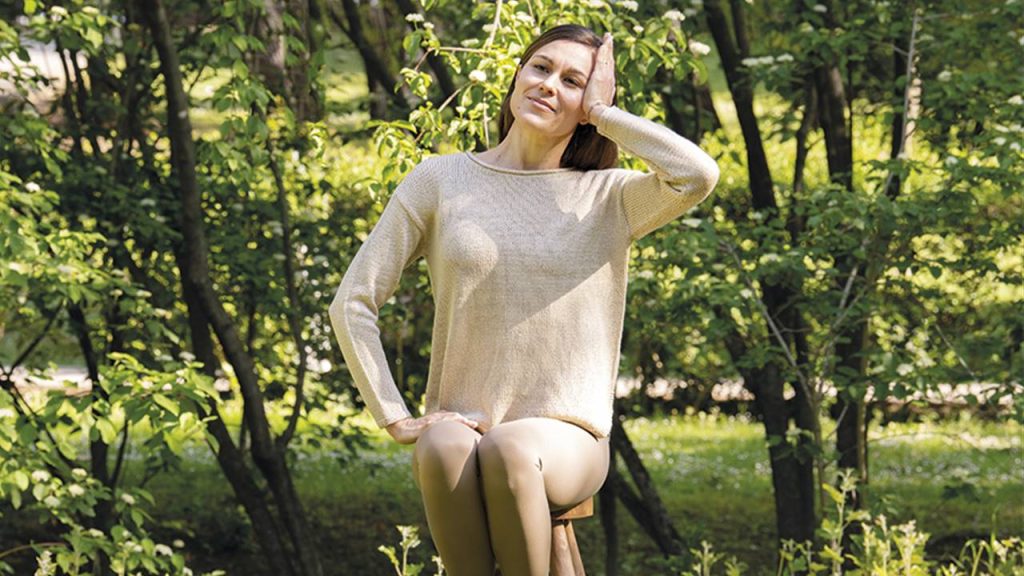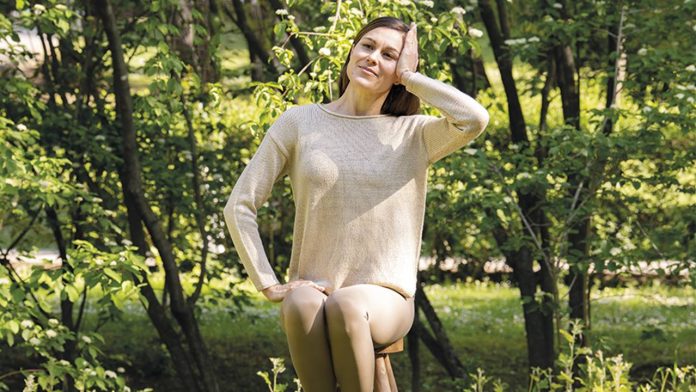Keeping your neck vertebrae in shape is the best way to protect yourself from the headaches that tension causes.

The nape of the neck supports not only much of the weight of the head but also much of the nervous tension experienced by the body: unconsciously the first thing we do when we feel pressured or overwhelmed is to lift our shoulders, which puts all the cervical muscles in tension.
The continuous work in front of a computer also increases the tension in this area, since the muscles of the eyeballs move coordinated with those of the upper part of the cervical. It is important to be aware of that tension that is accumulating in order to stop it.
WHY THE CERVICAL HURTS
We spend much of the day sitting in front of a screen with our eyes focused for hours. This leads us to generate imbalances throughout our body, but specifically in the neck and neck, which are very resentful. Chronic pain in this area is a common cause of discomfort and even sick leave.
The neck is connected to the entire body, so when we try to find and address the cause of neck pain, we should not focus only on this area. Often, that discomfort is the result of focusing too intensely on a single task, in this case, for example, staring at a computer screen without moving anything but the eyes, without a break.
What is the relationship between the neck, skull and eyes? At the top back of the neck, there are the suboccipital muscles. These muscles, inserted into the occipital bone at the base of the skull, respond to eye movements. However, its functions go further and intervene even in the coordination of the rest of the dorsal musculature.
In cats it looks great. Why do they fall on their feet? When in the air, they use their eyes and inner ear to orient their heads horizontally. This exerts certain stresses on your suboccipital muscles that the brain picks up through the stretch receptors and, reflexively, instructs the rest of the spine muscles to organize the spine from the neck and the legs are placed underneath before touching the ground.
We function in a similar way. The use of our eyes and neck will determine the usual tone of the rest of the dorsal musculature and, consequently, of the entire spine.
HOW TO PREVENT NECK PAIN
Moving the neck while in front of the computer will improve balance, coordination and mobility when standing and walking. If the first cervical is blocked, the vestibular balance system cannot function well, because the semicircular canals of the ear are related to the eye.
INSTANT EXERCISE TO RELAX THE CERVICAL AREA
Every time you notice that the head wants to hide between the shoulders, you can start by dropping it so that it resumes its natural position, stretching the back of your neck:
- Sit cross-legged and your back straight.
- Breathe in and stretch your arms above your head until you join the palms of your hands. Try to keep your shoulders down and your abdomen firm to protect your lower back.
- When exhaling, gradually drop your head forward, without straining, bringing your chin to your chest. Notice how the nape of the neck is stretching.
- Take a few seconds of deep breath and return to the starting position by undoing the steps.
If the tension is still excessive, different exercises and stretches can be practiced.
Isometric exercises, that is, those that do not involve movement, are especially useful. Only the hands are placed where appropriate and pressed for about ten seconds, massaging the muscles of the cervical area.
If the exercise is annoying, you have to stop practicing it.
EXERCISE ROUTINE AND POSTURES TO RELAX THE NECK
We present a series of exercises to release eye and cervical tension, as well as to strengthen the deep muscles of this area and improve general mobility. In addition, by understanding the relationship between the eyes and the neck we will give importance to active breaks during work and at the end of the day.
Pulling in front of the computer pushes us to lose consciousness of our body. Bringing awareness to the neck is key to maintaining a comfortable and healthy posture, even moving and feeling the rest of the body.
1. UNDO “KNOTS”
Get used to performing these exercises on a regular basis: they relax the cervical area and stretch the muscles.
- Stretch on the floor with your legs bent.
- Place a tennis ball behind your neck.
- Roll it up and down for 5 minutes.
2. RELAX THE NECK
- Raise your arm and rest your hand close to the opposite ear.
- Tilt your head to the side of your raised arm, facing the armpit and pushing gently with your hand, without bounces.
- Repeat 5 times on each side.
3. RELIEVES STIFFNESS
- Rest a towel at the base of the skull and grasp it at the ends.
- It tilts your head back a little and offers resistance by pulling the towel.
- Return to the starting position.
4. WEIGHT TO STRAIGHTEN
Standing or sitting, place a soft weight on the head; If you don’t have any, you can use a small sack of rice or chickpeas.
- Start with 1 kg and increase the weight gradually.
- It is not about moving anything, but about feeling in this position your feet well supported and the flow of your breath throughout the spine. You will activate the straightening by bra, but do not try to straighten yourself, do not force it, simply imagine that you grow from within. That will make you straighten up naturally.
- Hold the position for at least two minutes. You can also turn your head to look to your right and left, very slowly.
5. STRETCH YOUR ARM WELL
Standing, first observe your breathing and feel your feet well supported on the ground.
- Begin to slowly stretch your right arm. When you feel that you can no longer stretch it, without straining, open your hand and imagine that you want to gently push something.
- Without losing that tension, you laterally flex your neck to the left side. In this way, the entire muscular chain of the arm, hand and neck is stretched.
- Hold the position for three breathing cycles, and each time you exhale, stretch a little more. Then do it with the opposite side. You can also switch sides.
6. LATERAL ISOMETRIC
Sit on a stool or chair and place your right hand open over the temporal bone.
- It generates a slight resistance, that is, push your hand towards the head, while it makes force in the direction of the hand.
- Count five seconds as you focus all your attention on the movements of your breathing.
- Repeat five consecutive times and repeat the sequence with the other side. You will be activating the intrinsic muscles of the neck. Keep breathing flowing.
7. STRETCH THE ENTIRE SPINE
In the same chair with your hands clasped behind your neck, drop your head little by little, looking down and helping yourself with your hands.
- He descends by exhaling. Then, breathing, extend backwards, looking up. Matching movement with breathing is key.
- By stretching the spine in this way, it improves the mobility of flexion and extension of the neck.
- Then do a bending and extension exercise. Place both hands on the front bone, so that they are open. The goal is to generate a slight resistance with the head.
- Push with your hands towards your head, while trying at the same time to move it forward.
- Hold the position feeling the contrast of forces while counting to five and observe the rhythm of your breathing.
- Do it five times and repeat, but doing it with the back of the skull. On this occasion, to help you, you can try to do it with your hands intertwined. Don’t block your throat when pushing.
8. REST THE MIND
This relaxation exercise is ideal to end the day of work or if you feel very tired mentally.
- Lie on your back with an 18 cm diameter semi-swollen rubber ball, as a pillow.
- Put a bag of seeds, 8×8 cm, on your face, between your nose and eyes. With your eyes open and without tension, feel your breath. Then close them gently.
- Stay in this position for several minutes doing nothing, simply relaxing your face, eyes, nose and mouth.
TO PREVENT STIFFNESS ACTIVATES THE BODY’S MEMORY
If you spend a lot of time in the same position, for example in front of the computer, or if you have accumulated tension throughout the day, your cervical vertebrae are likely to accuse you. At first you may simply notice them somewhat strained, as if they were moving en bloc.
In the long run, if you do nothing to discharge them, that stiffness can lead to habitual headaches and loss of range of motion.
To avoid this situation, it is best to get used to doing several times a day some exercises that, accompanied by breathing, to relax the area.
Repeating these exercises increases the “motor memory” of the neck muscles, that is, it reminds you of your optimal state so that you can return to it. It also strengthens the muscles and thus helps correct bad postures that end up wearing out the vertebrae prematurely.
Always move your neck wisely, gently. If you have suffered an injury, such as whiplash, put yourself in the hands of a physiotherapist or an expert who tells you which movements are best for you.

